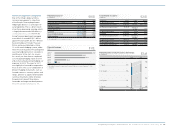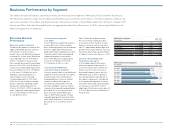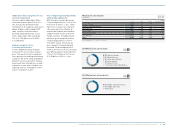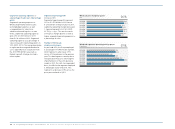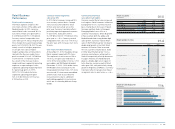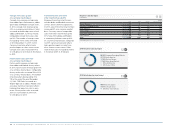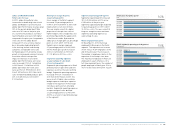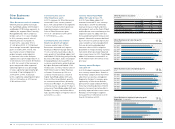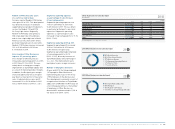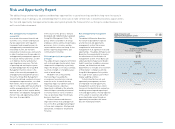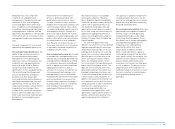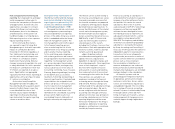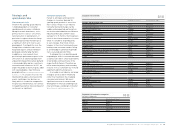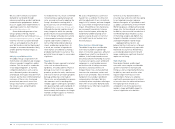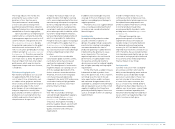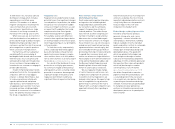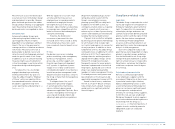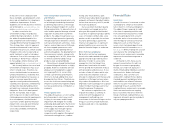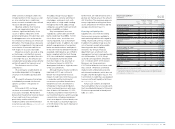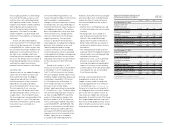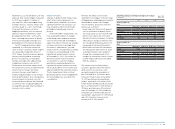Reebok 2010 Annual Report Download - page 163
Download and view the complete annual report
Please find page 163 of the 2010 Reebok annual report below. You can navigate through the pages in the report by either clicking on the pages listed below, or by using the keyword search tool below to find specific information within the annual report.
Group Management Report – Financial Review Risk and Opportunity Report 159
We believe that a key component
of optimal risk and opportunity
management is the identification and
evaluation of risks, risk-mitigating
actions and opportunities where they
arise. In addition, a concerted approach
to handling, monitoring and reporting is
of key importance. Therefore, risk and
opportunity management is a Group-wide
activity which utilises critical day-to-day
management insight from local business
units.
The main components of our risk and
opportunity management process are:
Risk and opportunity identification: The
adidas Group continuously monitors
the macroeconomic environment,
developments in the sporting goods
industry, as well as internal processes
to identify risks and opportunities as
early as possible. The Risk Owners
have primary responsibility for the
identification of risks and opportunities.
The central Group Risk Management
function has defined a catalogue of
potential risks (Risk Universe) to
assist and facilitate the Risk Owners in
identifying and categorising risks and
opportunities. On the one hand, the
respective Risk Owners actively monitor
the potential financial impact from
changes in the overall macroeconomic,
political and social landscape. On the
other hand, they closely observe brand,
distribution channel and price point
developments.
A key element of the identification
process is primary qualitative and
quantitative research such as trend
scouting, consumer surveys as well as
feedback from our business partners and
controlled space network. These efforts
are supported by global market research
and competitor analysis. Through this
process we seek to identify the markets,
categories, consumer target groups and
product styles which show most potential
for future growth at a local and global
level. Equally, our analysis focuses on
those areas that are at risk of saturation,
or exposed to increased competition or
changing consumer tastes.
Risk and opportunity evaluation: In order
to manage risks and opportunities in an
effective way, we evaluate identified risks
and opportunities individually according
to a systematic evaluation methodology,
which is applied consistently and allows
adequate prioritisation as well as
allocation of resources. According to our
risk management methodology, a risk
and opportunity score is calculated by
multiplying the potential financial impact
with the likelihood of occurrence. The
financial impact represents the biggest
possible potential effect on contribution,
with contribution being defined as
operating profit before intra-Group
royalties.
The financial impact is evaluated by
utilising five categories: Marginal,
Minor, Moderate, Significant and Major.
Likelihood represents the possibility that
a given risk or opportunity may occur.
The likelihood of individual risks and
opportunities is evaluated on a scale of
0% to 100%, using five classifications to
represent an aggregate likelihood for
various risk and opportunity categories:
Unlikely, Possible, Likely, Probable and
Highly Probable.
As risks and opportunities have
different characteristics, we have defined
separate methodologies for assessing
the potential financial impact. For each
individual risk, the gross risk score and
the net risk score have to be evaluated.
While the gross risk score reflects the
worst-case negative financial impact
before any mitigating actions, the net
risk score reflects the expected financial
impact after all mitigating actions. This
approach on the one hand allows for a
good understanding of the impact of an
individual mitigating action taken, and
on the other hand provides the basis for
scenario analysis and simulations. In
addition, the respective Risk Owners are
also required to assess each risk from a
timing perspective in order to determine
when the risk could materialise. In
assessing the potential effect on
contribution from opportunities, each
opportunity is appraised with respect to
viability, commerciality, potential risks
and the expected profit contribution.
This approach is applied to longer-term
strategic prospects but also to shorter-
term tactical and opportunistic initiatives
at both the Group and, more extensively,
the brand and market level.
Risk and opportunity handling: Risks and
opportunities are treated in accordance
with the Group’s risk and opportunity
management principles as described
in the Group Risk Management Policy.
Risk Owners are in charge of developing
and implementing appropriate risk-
mitigating actions and exploiting
opportunities within their area of
responsibility. In addition, the Risk
Owners need to determine a general
risk handling strategy for the identified
risks, which is either risk avoidance, risk
reduction with the objective to minimise
financial impact and/or likelihood of
occurrence, risk transfer to a third party
or risk acceptance. The decision on the
implementation of the respective risk
handling strategy also takes into account
the costs in relation to the effectiveness
of any planned mitigating actions if
applicable.


